Chimeras
and Other Oddities
Richard Cryberg
January
23, 2012
Mosaics:
Not
infrequently a pigeon is observed that has a patch that does not belong
with
the rest of the bird. For example a blue
bird might be bar pattern on one side and check pattern on its other
side. Quite often such a patch covers well under
half of the bird. In the above example
the check pattern might only cover a portion of one wing with the rest
of the
wing being bar pattern. Such oddities in
pigeons are almost always labeled mosaics by the pigeon
hobby. A few of them probably are mosaics as probably
every bird born is a mosaic by definition for some gene.
But, most are not mosaics at all. What they are, are
Chimeras.

The
definition of a mosaic is quite simple. It is an individual
that has developed from a
single fertilized egg and that individual has undergone a mutation at
some
point in development such that as an adult it consists of two
populations of
cells that differ genetically.1
All that has happened is some genetic accident happened after the
fertilized egg had undergone at least one cell division. The
accident could be a simple mutation of
some gene, it could be somatic crossing over resulting in a
recombination of
genes, or it could be a deletion or a transposition of a piece of DNA
from one
place in the chromosomal structure to a new place. The key
thing to recognize is all of these
started with one egg fertilized by one sperm forming one single
embryo.
Lab induced mosaics have been useful in
learning about early embryo development.
This is particularly true for mutants that would be lethal if the whole
organism were homozygous for the mutant.
As the average new individual has several mutations at birth that did
not come from either parent and also develops new mutations throughout
life it
is fair to say that probably every single multicellular organism is a
mosaic. If the mutation happens in the
right mass of cells early enough in life to be incorporated into the
ovaries or
testes the new mutation may be transmitted to offspring. On
the other hand if the mutation does not
end up in these tissues it is simply a dead end in animals and will not
be
transmitted. In plants mosaics are often
called sports. Plants can usually be
reproduced from a tissue sample by either grafting or by rooting or
tissue
culture. So mosaics on plants are often
a source of new phenotypes as the mutation does not need to be present
in the
reproductive organs. There is no reason
at all to think that the tendency to produce true mosaics could be
inherited. In fact if a strong tendency
to form true mosaics could be inherited the DNA for that individual
would be so
unstable that the individual would likely be dead before
birth.
If nothing else cancer should kill it
fast. After all, some types of cancer are simply
mosaics.
Chimeras:
Hollander
wrote a paper which he mistitled “Sectorial Mosaics in the
Domestic Pigeon: 25 More Years” in 1975.2
He
presents data on some 40 different birds,
many that showed patches that differed by two or more mutants from the
rest of
the bird.
In this paper he actually
presented the correct interpretation for such animals as being due to
chimeras
as one possibility.
A chimera is simply
an individual that consists of two or more populations of cells that
originated
from different zygotes.
Chimeras are
actually quite common and in some animals most individuals born are
chimeras3. A
well understood chimera in cattle involves
opposite sex twins. The
female will
generally be sterile as she will have acquired tissue from her male
twin in
utero and that male tissue will
prevent proper sexual development of
the female4. These
part male,
part female chimeras share the same immune systems as can be
demonstrated by
viability of skin grafts between the male and female.
That
such females were chimeras has been
known since the 1940s when it was very well documented by another of
Cole’s
students, Ray Owen5.
Hollander knew about
Owen’s work quite well as they actually worked
together on a project right at the end of Hollander’s PhD
work.
Why he seems to have ignored
Owen’s work is a
puzzle.
More
recently it has been shown that in birds sexual expression is not a
matter of
general hormone levels through the body.
Rather, each individual cell has a sexual identity based on the
chromosomal content of that cell. In
chickens it has been well known for some time that roughly one bird in
5000
exhibits patches where part of the bird has cock plumage and the rest
has hen
plumage6.
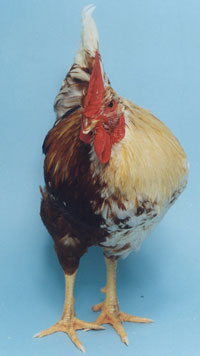
Picture
1.
A half
male, half female chicken
.
 6
6
 7
7
Even
humans have been identified
who have had two, genetically
totally different, populations of cells7.
In
his 1949 paper8
on this subject Hollander
concluded that he favored an explanation for animals that had two
genetically
different populations of cells being the result of one egg being
fertilized by
one sperm forming perfectly normal tissue and a second sperm forming
haploid
tissue without any fertilization of an egg.
This haploid tissue then
became incorporated into the embryo. In
his 1975 paper he readily admits that
“Double fertilization of a binucleate egg, however,
could
explain most cases as well,” He
also goes on to make the incredible
comment “It is regrettable that, to date, no karyotype
studies have been
attempted….it would be interesting to know if haploidy is or
is not
involved.”
In fact it is incredible that
he was able to publish this paper without karyotype data.
Such
data was easy to obtain by that late
date.
Clearly all the equipment and
skills to carry out such a determination were at his ready disposal at
Iowa
State University.
The fact he did not do
this simple experiment is telling. It
seems to say he did not wish to know that his haploid tissue idea was
incorrect.
And unfortunately it has laid
the seeds for continued confusion on the subject ever since. Some
people even seem to think Hollander
claimed two sperm fertilized one egg and that somehow lead to what he
incorrectly called mosaics.
Two sperm
plus one egg does happen rarely and results in a triploid embryo which
is fatal
before hatching.
In general, biology has
reasonably robust restrictions that prevent a second sperm from
entering an
egg.
In fact, many of the birds
Hollander
called mosaics are
clearly not mosaics at all.
Any that he
claimed to be the product of more than a single sperm by definition
were not
mosaics.
They were not considered
mosaics by the time of his last paper in 1975 nor even 25 years before
then
when he had published his earlier paper.
What they are known to be are
chimeras.
Chimeras have been well studied in
the laboratory.
Natural chimeras are not
particularly
uncommon.
They are also reasonably easy
to make artificially.
Artificial
chimeras can be made by grafting operations on embryos or by embryo
fusion.
For instance here is a link
to a
picture of a chimera made by fusing a sheep and goat embryo:
http://en.wikipedia.org/wiki/Sheep%E2%80%93goat_chimera
Making a chimera of a mammal in the
laboratory is straightforward.
All you need to do is either
push two early
embryos together in a petri dish and culture under conditions that will
allow
growth or inject stem cells into an early stage embryo, again in a
petri dish.
In either case the resulting
chimeric embryo
is transplanted to a suitable female for gestation.
Chimeras
of birds are also quite easy to make
either by tissue grafting to a developing embryo or injection of stem
cells
into a developing embryo.
With birds the
developing embryo is not removed from the egg to perform the grafting. Male
chimeras produced by injecting cells
from a duck embryo into a developing chicken embryo were even able to
produce
both viable duck and chicken sperm9.
Females of the same origin
were able to produce both viable duck and
chicken eggs.
In a bird the most logical way a
natural chimera could
happen would be if two eggs were deposited on one yolk.
If
both eggs got fertilized, each by a single
sperm, the result would be two embryos located right next to each other. During
development these two embryos could
easily fuse and become one individual.
This does present the problem
as to how two eggs happened to end up
deposited on one egg yolk.
The easiest
way for this to happen is simply for an error in the cell divisions
that form
an egg to happen.
If you recall meiosis
to form an egg involves two sequential cell divisions.
Here
is a link that covers meiosis in
pictorial form:
https://www.angelfire.com/ga/huntleyloft/images2/Graphic_3.gif
Or, if you want a detailed
presentation of meiosis here
is another link:
http://en.wikipedia.org/wiki/Meiosis
Briefly
what happens is the chromosomes are doubled so each
cell has two of each
chromosome. The
original and daughter chromosomes remain
bound at the centromere.
Crossing over takes
place and then the first cell division takes place.
One
chromosome and its daughter chromosome
still attached go to one of the new cells and the homologous pair goes
to the
other cell.
These cells usually differ
greatly in size if the final product will be an egg.
Almost
all cytoplasm goes to one of the new
cells while the other gets very little cytoplasm. Thus,
in birds one of these cells is male and
the other female.
This cell division is
followed by a second cell division for each of the cells produced in
the prior
step.
In this case the chromosome
pairs
are pulled apart from the centromere attachment resulting in all
haploid
cells.
Again the cell destined to be
the
egg gets almost all the cytoplasm while the other cell usually gets
little
cytoplasm.
The net result of this
process
is four cells in total.
One is quite
large and contains almost all the cytoplasm that was in the starting
tetraploid
cell.
The other three are tiny by
comparison and nearly lack cytoplasm.
All three small cells are
called polar bodies.
The cell that got almost all
the cytoplasm
also got most of the small structures found in a cell such as
mitochondria.
Those structures are
critical to proper cell function and without them the cell will shortly
die.
The polar bodies simply do
not have
critical components that allow survival usually.
However,
if an accident happens during some stage of cell
division and the cytoplasm is distributed equally or nearly equally the
result
would be two potentially functional eggs.
After all, the polar bodies
have 100% of the genetic machinery they need
to function as eggs.
All they lack would
be cytoplasm for a food source to support the first few cell divisions
and a
functional number of mitochondria. If
the more equal than normal cell division happened during the first
meiosis
division the result would be one male egg and one female egg.
Thus
the chimera produced would be a dual sex
individual.
Some pigeons Hollander
examined surely had signs of sexual maldevelopment that could easily
have been
the result of a dual sex individual. And
clearly the cardinal and chicken cases cited earlier show that such
dual sex
individuals are possible.
On
the other hand if the accidental more equal than usual
cell division happened during the second cell division of meiosis the
two
populations of cells would be same sex.
Such same sex individuals
would be expected to be normal in terms of
reproduction.
A
number of people have reported lines of birds that tended
to produce such chimeras regularly. In
one case a chimera hen pigeon produced eight out of ten young that were
also
recognizable chimeras in one year10.
Generally they are improperly
called mosaics out of habit.
It should be quite possible
to develop lines
of birds that had this tendency. After
all, those cell divisions that happen during egg formation are under
genetic
control.
All that has to happen is to
change those genes that govern unequal cell division in favor of more
equal
cell division and you are going to have a line of birds that will
produce such
freaks.
It is worth noting that
chimeras
in birds are 100% the result of what happens in the female.
So
it is her genes that will govern how
equal, or unequal, those critical cell divisions happen to
be.
However,
in development of a line of birds
with the tendency to produce chimeras the father of the hen is just as
important as the father is in a Racer, a
Roller or a show bird.
Mating a son back
to a hen that has produced chimeras should be a good mating to capture
the
trait.
It is even possible that
different genes are involved in the two different cell divisions so
perhaps
with selection you could largely avoid making the dual sex chimeras
that might
have health issues.
1. Strachan, Tom; Read, Andrew P.
(1999). "Glossary".
Human Molecular Genetics
(2nd ed.). New York: Wiley–Liss. ISBN 1-85996-202-5.
2.
Hollander, W. F., Sectorial
Mosaics in the Domestic Pigeon: 25 More Years, J. Hered 66:
177-202
(1975)
3. Ross, C. N.; J.
A. French, G.
Orti (2007). "Germ-line
chimerism and paternal care in marmosets (Callithrix kuhlii)".
Proceedings
of the National Academy of Sciences
104
(15): 6278–6282.
4.
Padula
AM., The
Freemartin Syndrome: An Update,
Anim Reprod Sci.
2005
Jun;87(1-2):93-109. Epub 2004 Dec 10.
5. http://oralhistories.library.caltech.edu/123/1/Owen_OHO.pdf
6. http://www.nature.com/news/2010/100310/full/news.2010.114.html
7.
http://www.scq.ubc.ca/the-truth-about-chimeras/
8. Hollander,
W. F.,
Bipaternity in Pigeons, J. Hered, 50:271-277(1949)
9. Z.
D. Li, H. Deng,
C. H. Liu, Y. H. Song, J. Sha, N. Wang and H. Wei, 2002 Poultry Science
81:
1360-1364
10. James
Turner,
private communication
~.~.~.~.~.~.~.~.~.~.~.~.~.~.~.~.~.~.~.~.~.~.~.~.~.~.~.~.~.~.~.~.~.~.~.~.~.~.~.~.~.~.~.~.~.~.~.~.~.~.~.~.~.~.~.~.
A
mosaic of what used to be Mosaic photos
but
in truth, it is a mosaic of Chimeras
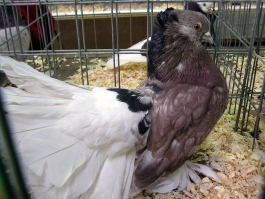
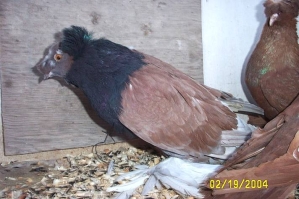
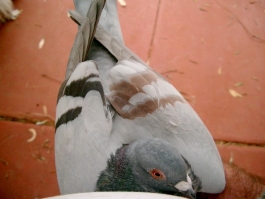
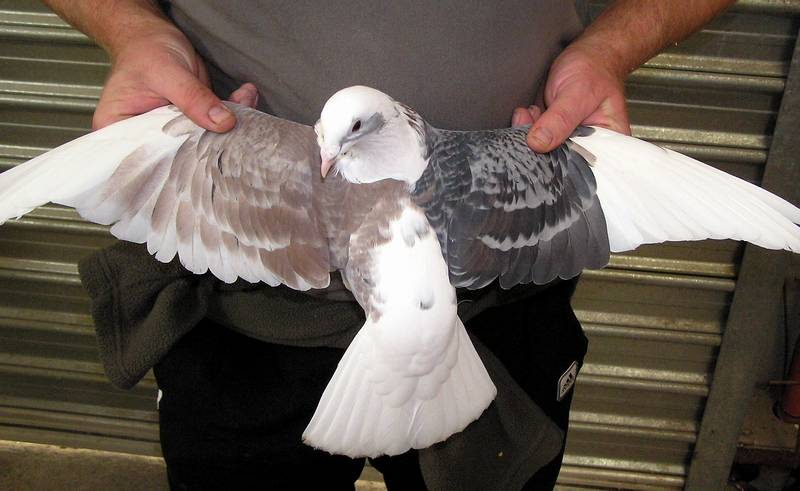
Five Chimeras photos by Michael Spadoni of Geelong Australia


Half Smoky / Blue bar by AL Neese
and
a Half Mealy / Grizzle by Larry Davis


These two photos of the same bird were taken by David M. Longseth at
the 2003 NYBS.
The right wing shield is a blue check while the left side is a dark
'dun/brown' color with heavy black flecks or sootiness.
This left side may be almond as the sire was an almond bird.
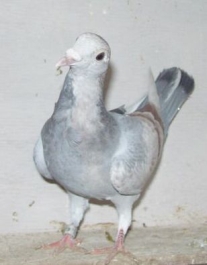
This
young homer cock belonged to Timothy Hume of Saltspring Island, BC
Canada.
It was killed at age four by a falcon. The bird was both a blue bar and
a mealy.
Email the author, Richard Cryberg:
Email: Site Owner
Back To Start Page
Copyright
2011 by Richard Cryberg
Permission is granted to download or copy for non-commercial individual
use only.
The author retains all other rights under copyright.
Ronald
R. Huntley
Web Page Designer
Duncan SC, 29334
phone: (864) 249-0276



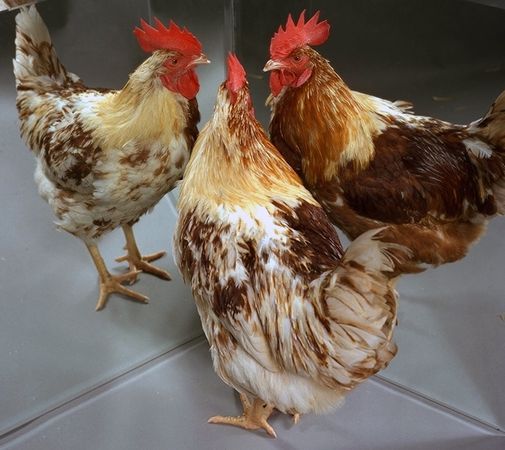
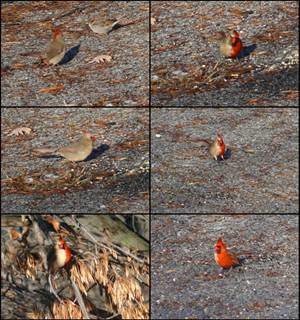
 4
4
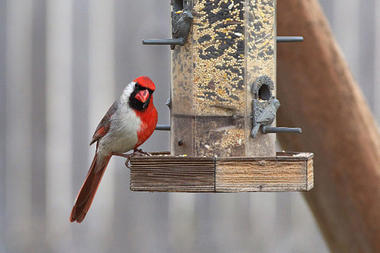 5
5 6
6
 7
7







